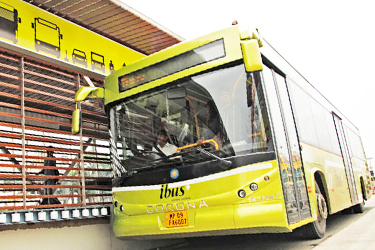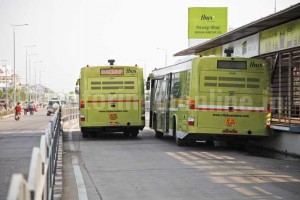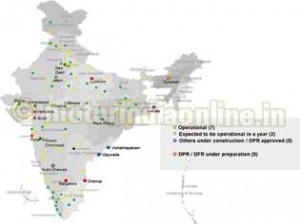
By Dario Hidalgo, Director of Research and Practice, EMBARQ Network
During my first visit to India in 2006, I presented Latin American experiences with Bus Rapid Transit (BRT) at a conference organized by the Indian Ministry of Urban Development. At that time BRT seemed a distant dream for the Indian context. Now it is a reality for several cities and a clear possibility for many more.

Over the past four months, two cities in Madhya Pradesh launched their Bus Rapid Transit systems. Indore, the State’s commercial hub, which began trial runs in April, is already operating commercially, and the system is expected to be officially launched in the next two weeks. Bhopal, the State capital, quickly followed suit, with trial runs of the new system made on June 1.
These two cities join Pune, New Delhi, Ahmedabad, Jaipur and Rajkot, bringing the total count of India’s BRT systems and bus corridors to seven. Two additional cities, Surat and Pimpri-Chinchwad, are expected to launch their own advanced bus systems later this year. Five more cities have BRT lines under construction, and an additional five have announced future plans to build such a system. In less than a decade from now, the number of BRT systems and bus corridors in India will have gone upto 19.
This rapid spread of advanced bus systems has been due to strong local leadership and national technical and financial aid. Bhopal and Indore both benefited from the support of the Jawaharlal Nehru National Urban Renewal Mission (JnNURM), an ambitious national government program to support urban development and reform across a rapidly urbanizing country. The growth of advanced bus systems in India has also benefited from the support from academic institutions like CEPT University and IIT Delhi and a wealth of international expertise shared through multilateral institutions and NGOs, including UNDP, the World Bank, the Asian Development Bank, EMBARQ, ITDP and Clean Air Asia, to name a few.
Indore and Bhopal systems
The Indore BRT corridor, iBus is an 11.4-km corridor with 21 median stations, and custom-designed air conditioned buses. It is currently carrying over 19,000 passengers per day and is expected to serve more than 70,000 once the fleet of 50 buses is completed. The corridor has all the necessary features to be considered a full BRT system: bus stops in the road’s median, stations with pre-payment and level boarding, quality buses, information technologies and a distinctive image.
The plan for Indore’s bus corridor was approved in October 2006, and after overcoming multiple financial and legal challenges, it initiated trial runs last April. As seen in many other projects, the system started as a “work in progress.” The advanced wireless-solar signalling system is yet to be implemented, and the full bus fleet is not yet up and running. But already the experience of riding Indore’s BRT is a big change for users: buses flash through the congestion on the Agra-Bombay Highway – a large, inter-State highway known as the AB Road – providing the fastest travel across the city.
Very shortly after the launch of the system in Indore, Bhopal started trial runs of a section of its 23-km bus corridor. The MYBUS system, also funded by the national JnNURM program, features central bus lanes, island stations and low-floor buses.

According to initial measurements, the commercial speed of Bhopal’s MYBUS is 27 per cent above the average on the general traffic lanes, providing users with a quick ride across town. Completion of the full corridor is expected in the next three months.
During my visit to these two systems in Bhopal and Indore, I could see that the new advanced bus systems give citizens a reason to be proud of their city. Progress really gets reflected in quality public transport. Will these systems help popularise BRT across India? It is still too early to declare Madhya Pradesh’s first two BRT systems a success. But they have very strong characteristics and show that it is possible to adapt the BRT concept in different contexts.
In 2011, Ahmedabad started operation of a section of its 45 km Janmarg system, with plans to expand it to 108 km within three years. When the Janmarg system was presented in other parts of India, some people said it was not possible outside Gujarat. Now, two advanced bus systems are operational in Madhya Pradesh, with systems under construction in Naya Raipur, Hubli-Dharwad, Pimpri-Chinchwad and Surat and those on the drawing board in Mumbai and Bangalore, among others.
Though India was slow to begin investing in BRT Systems, I believe we are witnessing a “tipping point.” Bus Rapid Transit in India is finally taking off.
(As seen on www.thecityfix.com, produced by EMBARQ)